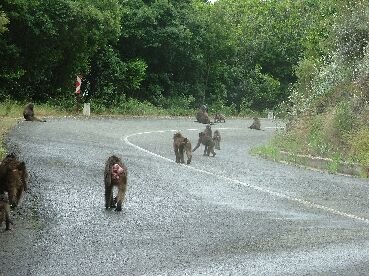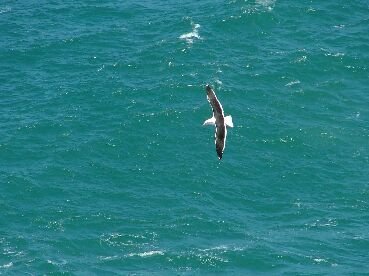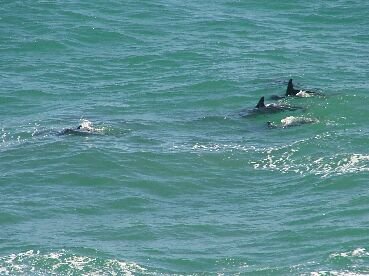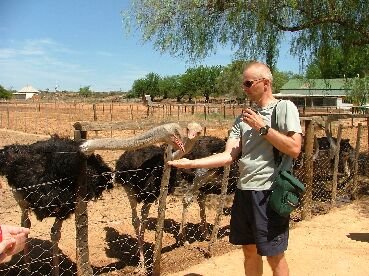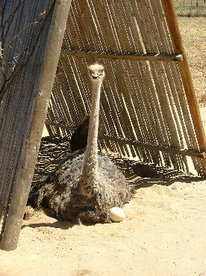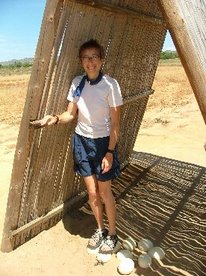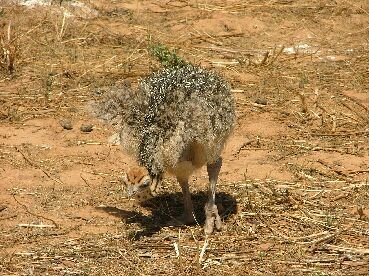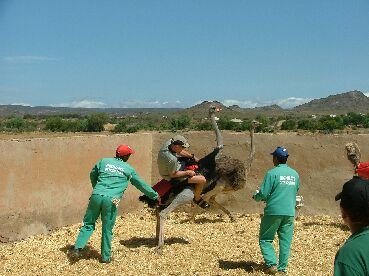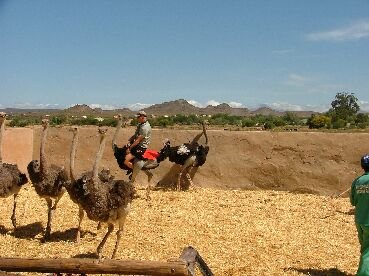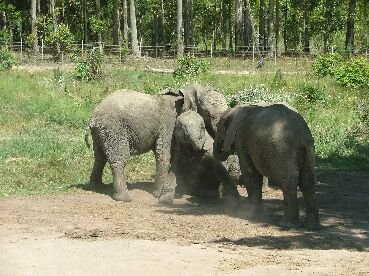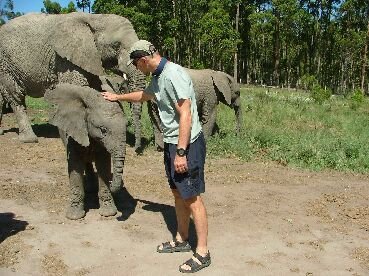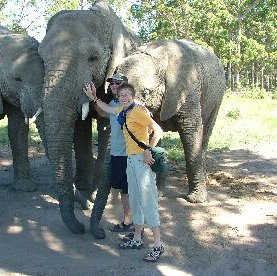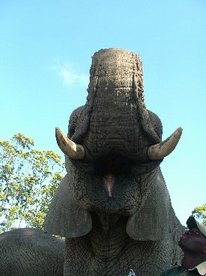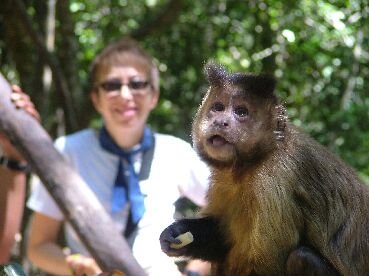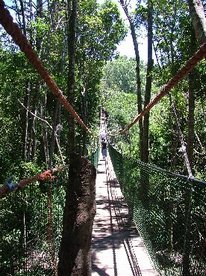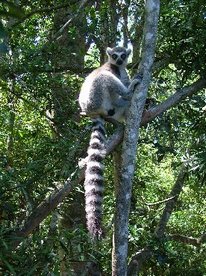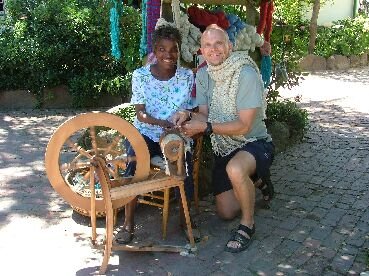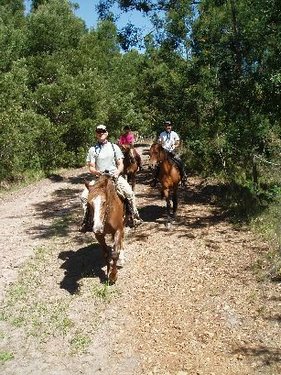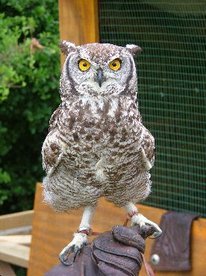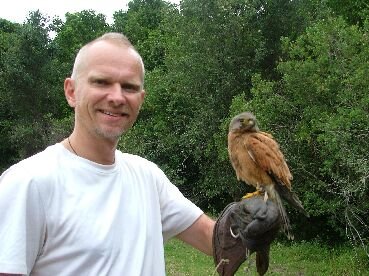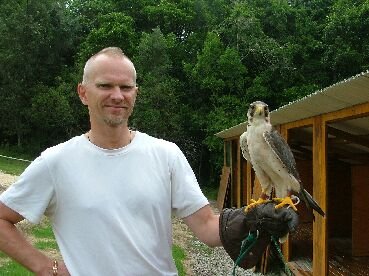|
|
WhereAreJanetandRick South Africa |
|
The Garden Route and Klein Karoo
Caution, Baboon Crossing
Mossel Bay is about 2 hours east of Cape Town along the N2 highway. The Garden Route is the road that hugs the Indian Ocean coast east from Mossel Bay to Port Elizabeth. The downside of our trip was that you need at least a month to do this route any justice and we took barely a week. The upside was that wherever we stopped, it was amazing.
Off of the N2 are regional roads where the picture at left is not at all uncommon! The Klein Karoo, or little Karoo is a semi-desert like region between the 2 mountain ranges along the southern part of South Africa. More on that later.
Oystercatcher Trail, Mossel Bay to Dana Bay
The Oystercatcher Trail runs east from Dana Bay along the coast. We met a man who drove with us to Dana Bay, where we left our car, and shuttled us back to the start of the trail. We walked the 14.5 km west from Mossel to Dana Bay. Pictured at right is the typical view looking west.
For most of the way, we walked along the top of the escarpment. To the sound of the waves crashing below us, we saw many colourful semi-desert plants and various birds cruising the seashore for fish. Pictured at left is a gull hovering above the water.
At one point, the trail descended to the beach. We were lucky enough to see a pod of dolphins frolicking off the shore!
Highgate Ostrich Farm, Outshoorn
We crossed the southernmost mountain range into the semi-arid desert that is the ideal climate for ostriches. The town of Outshoorn sports at least 5 ostrich farms – we toured Highgate.
Pictured at left is Rick feeding an ostrich with a second looking on and feeling left out.
At right is Suzy. She’s trying to hatch some eggs. Unfortunately for Suzy, tours keep coming through and chasing her off her eggs.
At left is Janet standing on 4 ostrich eggs!!!! After Suzy was let back, she rearranged her eggs and continued hatching (until the next tour). Female ostriches sit on the eggs during the day and the males take over the honour at night!
Once the eggs hatch, the resulting chicks look like the one at right. After about a year, the males grow black and white plumage and the females retain the brown-grey colouring.
And now for the fun, the reason that we came to Highgate. Here’s Janet sitting on top of a male ostrich. He’s also loaned her his feathers to formalize her attire for the occasion! Doesn’t she look classy!?!?
Here’s Rick showing novice jockeys how to properly bank an ostrich in a turn – okay, this is really why we came to Highgate!!
The ride continues! Notice the 4 females running interference.
Knysna Elephant Park
Back on the coast at the Knysna Elephant Sanctuary, these young guys are frolicking in the dirt, waiting for their turn at the tourists.
These rescued elephants live in the lap of luxury at Knysna. They sleep indoors, have acres of land to find the 200 kg of food that they each consume daily, and get treats from tourists that come to visit. Here’s Rick feeding one of the residents.
After the feeding, the kids get to play with the tourists. Here’s the youngest checking Rick out!
After the feeding, the elephants let the tourists come and pet them. After that social appearance, off they go to graze until the next batch of tourists arrives.
This guy is showing his teeth. With age, an elephant’s teeth wear down and they are no longer able to chew their food enough to nourish themselves properly. When this happens, most elephants starve to death. When this starts to happen, many elephants leave the herd and lead solitary lives until they die.
Monkeyland
Another sanctuary that we visited was Monkeyland. They bill themselves a monkey refuge for monkeys rescued from labs, pet owners who can no longer care for their apes, etc. Their mission, as presented, sounded noble enough, but when we were advised of a scheme to rescue mountain gorillas from the Congo, we became quite dubious that they were anything more than a money-making enterprise (having observed these wonderful creatures (gorillas) in the wild in Uganda, just across the border from the Congo, and talked to fellow travellers who visited gorillas in both the Congo and Rwanda, it sure didn’t appear to us like they needed any rescuing).
Here’s a ‘Capuchino’ monkey. This is the species that is most often used as organ-grinders in circuses. Some have purportedly been trained to look after residents in old age homes. We are told that they can be trained to dial emergency telephone numbers (unfortunately, they can’t understand the prompts that must be followed when you reach an emergency number these days!). They also sport the most amazing hair-styles. Pictured here (at right) is Elvis – you might be able to make out Janet in the background.
Monkeyland boasts the longest suspension bridge in the southern hemisphere. We are told that it is a few meters shorter than the Kapilano Bridge in North Vancouver in Canada.
This strip-tailed lemur is native to Madagascar. They have dog-like snouts and make sounds not that different from the barking of a dog. Notwithstanding the resemblance to canines, they are very able tree climbers!
This sorry-looking spider monkey is called Tarzan. We’re not sure of his story, but he was trying to steal lunch from the outdoor café. While we were waiting for our lunch, we were served coffee and a ¾ filled 500 ml water bottle with a mismatched cap and neck. We figured that the waiter thought that it was ours until we noticed another waiter squirting Tarzan with a similar bottle. On further examination, we noticed that our bottle also had a hole in the top – the purpose was now clear! Poor Tarzan.
Old Nick, Plettenburg
On our way back from the dubious Monkeyland, we stopped at a craft area called Old Nick. Leave it to Rick to find a wool scarf in 35 deg C weather. Here’s Rick (right, sporting scarf) and Marty (she hand-knitted the scarf on the spinning wheel shown). The spinning wheel is her late grandmother’s. She used to play with the wheel as a child and only learned how to use it after her grandmother passed away. Rick will proudly wear that scarf when he arrives home next week!
Horseback Riding
After buying the scarf, we rushed back to the Southern Comfort Ranch where we were staying for our 2:30 horseback riding appointment. Unlike earlier-life less-than-pleasant horseback riding experiences, we both had great fun with our horses Elusion and Star!
Birds of Prey Sanctuary
Our last formal animal experience was at the Birds of Prey Sanctuary (next to dubious Monkeyland). This was a highlight for Rick (who was probably a bird of prey in a previous life).
This spotted eagle owl was ‘rescued’ from a lab (sounds like a standard line). She is one of 2 sisters that reside at the sanctuary. Look at those piercing eyes - the sockets don’t move, but the owl’s neck has 37 vertebrae (to our 7), allowing 180 deg of motion. The other cool thing about the owl is that as you move your arm up and down, the owl’s head stays in the same spot! The owl sisters are habituated to humans and they allow you to pet them. They are so soft to the touch – it’s almost like the feathers have no weight!
Here’s Rick (left) with a rock kestrel. This little guy (the kestrel) hunts insects and small birds and rodents. In the tuck, they dive at 200 kph and grab their prey with their talons. We’re told that autopsies performed on prey show that most internal organs are ruptured from the impact of the dive!!
(The peregrine falcon (not shown) is not much bigger than the rock kestrel, but sets the bird of prey dive record at 380 kph!!)
This lovely honey buzzard (right) has talons – check out those magnificent yellow claws. Honey Buzzards are unlike other large raptors in that they specialise in eating insects, with wasp and bee larvae making up a large part of their diet. They have adaptations that protect them from stings and help them deal with their prey. They are not entirely dependent on insects; frogs, young birds and even some fruit are taken as alternative prey.
| |||||||||||||||||||||||||||||||||||||||||
